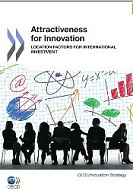 Author: OECD, WPGI (paper written by Koen Debacker and Fabrice Hatem)
Author: OECD, WPGI (paper written by Koen Debacker and Fabrice Hatem)
Date of declassification: october 2001
Tto download de the full report, click on: OCDE
Virtually all governments are keen to attract international investments by multinational enterprises (MNEs) as these promote growth and employment by creating new jobs, realising new investments and bringing in new technologies. Policy makers are interested in the direct and indirect value that new investments by MNEs can bring to their country. By encouraging multinationals to establish local affiliates host countries hope to generate technology transfer to local firms since foreign direct investment (FDI) is one of the most important channels through which technology is transferred across countries.
Attractiveness for investment in innovation is high on the policy agenda in many countries as innovation has become a key factor of growth and competitiveness in OECD countries. Further on, MNEs are central actors in the (global) innovation process and consequently, ‘national’ innovation activities in host countries are to a large extent affected by international location decisions taken by MNEs. Consequently, there is a growing interest among OECD member countries to formulate policies aimed at fostering territorial attractiveness for particularly high-tech, R&D and innovation activities.
While every country and region has some policy measures in place that are aimed at increasing attractiveness (for innovation), it is less clear if these policies are effective. Evidence for some countries suggests that a coherent and structured strategy to attract investment is not always in place and negotiations with international investors are often tackled on an ad hoc basis. At the same time, a growing policy competition between countries is gaining momentum in attracting international investment.
OECD countries are confronted with an increasing competition from emerging countries for international investments, not only in more labour intensive activities but increasingly also in innovative activities. This has raised concerns in (some) developed countries about their long term economic future: after the relocation of major production and distribution investments by MNEs (including their own indigenous MNEs), do they now risk to lose also higher value added activities like R&D and innovation related activities to emerging economies?
This reports analyses the current trends in international investments in innovation (Chapter 1) and discusses the attractiveness of countries for international investments in innovation (Chapter 2). Because innovation is a broad and complex concept encompassing a range of inputs and outputs within and across the activities of firms, locations factors are discussed based on both an industry and a business functions approach. The industry approach focuses on high‑technology industries, defined by the OECD as those where the R&D effort is the highest. The business function approach focuses on the most innovative activities in companies’ global value chains: R&D corporate functions and headquarters which both are supposed to play a determining role in the innovation strategy of multinational enterprises.
The report discusses attractiveness policies for innovation that countries have implemented (Chapter 3) which are often based on the more traditional instruments for attracting international investments in general. The evidence presented raises some policy issues and questions on existing policies for attracting international investments particularly in innovation: the need for a broad versus targeted policy approach, the links with other (innovation) policies, etc. Based on this discussion, a number of policy principles are formulated intended to guide policy makers in formulating more effective attractiveness policies for innovation. In addition, this report notes the negative effects of the increasing policy competition between (OECD) countries in attracting international investments, including bidding wars between countries to attract individual investors through direct financial and fiscal incentives.
This report is based on the work that has been undertaken by the Working Party on Globalisation of Industry (WPGI) during the past two years: a literature review and desk research; statistical and econometric analyses; policy surveys and questionnaires. The different activities have directly contributed to the OECD Innovation Strategy and the results are presented in this thematic report. The report has been prepared by Koen De Backer of the OECD Secretariat and Fabrice Hatem who acted as consultant.